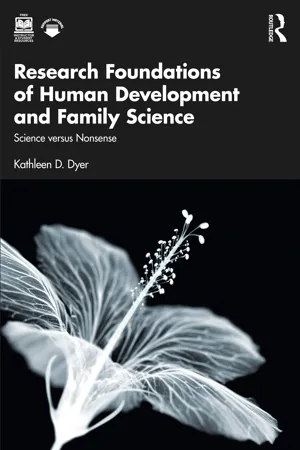
Research Foundations of Human Development and Family Science
Science versus Nonsense
Kathleen D. Dyer
- 264 pages
- English
- ePUB (adapté aux mobiles)
- Disponible sur iOS et Android
Research Foundations of Human Development and Family Science
Science versus Nonsense
Kathleen D. Dyer
À propos de ce livre
Human Development and Family Science (HDFS) is an interdisciplinary and applied field that draws from developmental science, family science, and other social sciences. Research Foundations of Human Development and Family Science is a textbook that provides an introduction to the diverse scientific research methods that form the foundation of scholarship and practice in HDFS.
In Part I, Kathleen D. Dyer explores science. She distinguishes empirical scientific research from common sense and from knowledge gained from personal experience. This section also includes a discussion of the strategies used by pseudoscience to exploit the well-deserved credibility of science, providing relevant examples. Part II examines systematic empiricism through sampling and measurement. HDFS scholars use a wide array of measurement tools, including self-report (interviews, questionnaires, and self-report tasks), observations (participant, naturalistic, and structured), objective tests, physiological measures, and several types of archival records. Part III introduces the use of study design to achieve falsifiability in scientific research, including an overview of various orientations to time used in research as well as four different study designs: qualitative, prevalence, correlational, and experimental. Finally, Part IV addresses the public verifiability of science, including how scientific consensus is developed, the use of literature reviews to identify convergence of evidence, and how scientific literacy translates into evidence-based professional practice.
Illustrated throughout with studies foundational to the discipline as examples of the strategies described in the text, Research Foundations for Human Development and Family Science is a comprehensive, accessible core textbook for undergraduate research methods classes in HDFS. It introduces the discipline of HDFS and challenges students to understand the limitations of common sense and the threat of pseudoscience for those work professionally with children and families.
Foire aux questions
Informations
Part I Human Development and Family Science
History of HDFS as a Scientific Discipline
- Name the three disciplines from which HDFS emerged.
- Why have these three disciplines merged into HDFS? What do they have in common?
Types of Scientific Questions in HDFS
- Insight: Some scientific research in HDFS seeks to gain insight about a topic to help us organize our knowledge about it. These questions are usually about subjective personal experiences, and help us to broaden the way we think about a topic. Research designed to answer insight questions uses a qualitative design. Examples might include the following:
- What do children think makes someone a friend? How do children conceptualize betrayal? Loyalty? Why do friends sometimes forgive each other, and sometimes choose not to?
- What do people want in a dating partner? In a marriage partner? What are “deal-breakers” in committing to a relationship?
- For what reasons do people decide to become parents or not to do so? How do people feel about these decisions after the fact?
- How do adults cope with breakup? Divorce? Loss of a child? How do they make sense of these experiences? Whom do they blame, if anyone? How do they face the future? Please notice that insight questions do not have correct or incorrect answers. They are fundamentally subjective in nature; they examine the experiences/beliefs/perspectives of people. They tend to be open-ended questions that lend themselves to exploration with an open mind. They are also helpful for organizing information, which is the process of theory-building.
- Prevalence: Other scientific research in HDFS seeks to identify how often something happens, or how many people have a given experience or have a given opinion. Research to answer prevalence questions is designed to count something. Examples might include the following:
- What percentage of children experience parental divorce? Child abuse? Bullying?
- What is the birth rate in a particular place? The infant mortality rate? The marriage and divorce rates?
- At what age do most babies roll over? Crawl? Walk? Talk?
- What is the average age of first sexual experience? Of first marriage? Birth of first baby? Menopause? Are those average ages changing over time? Please notice that prevalence questions are all about counting something. In that sense, they are objective in nature. The result of each question is a number. The number is not a matter of opinion.
- Correlation: Other scientific research in HDFS is to find out if two or more things are associated with (or correlated with) each other. Research to answer correlational questions is designed to identify relationships between naturally occurring things. Examples might include the following:
- Do parents who sleep with their babies get more or less sleep than parents who do not?
- Do children of different racial or ethnic backgrounds have different experiences with law enforcement? With school teachers? With neighbors and friends?
- Is divorce more or less likely when couples are far apart in age? When they have different religious beliefs? Notice that these questions always ask about two or more things because this kind of research is all about whether things are related to each other. These questions only ask about whether things are correlated with each other; they do not ask for an explanation for that correlation. These questions simply deal with the existence of a relationship, not its reason. That may seem like a strange limitation, but it is because explanations are much more difficult to determine than correlations, and often they require very different research methods. Furthermore, notice that these questions...
Table des matières
- Cover
- Half Title
- Title Page
- Copyright Page
- Contents
- Preface
- PART I: Human Development and Family Science
- PART II: Systematic Empiricism Through Sampling and Measurement
- PART III: Falsifiability Through Study Design
- PART IV: Public Verifiability for Evidence-Based Practice
- Index